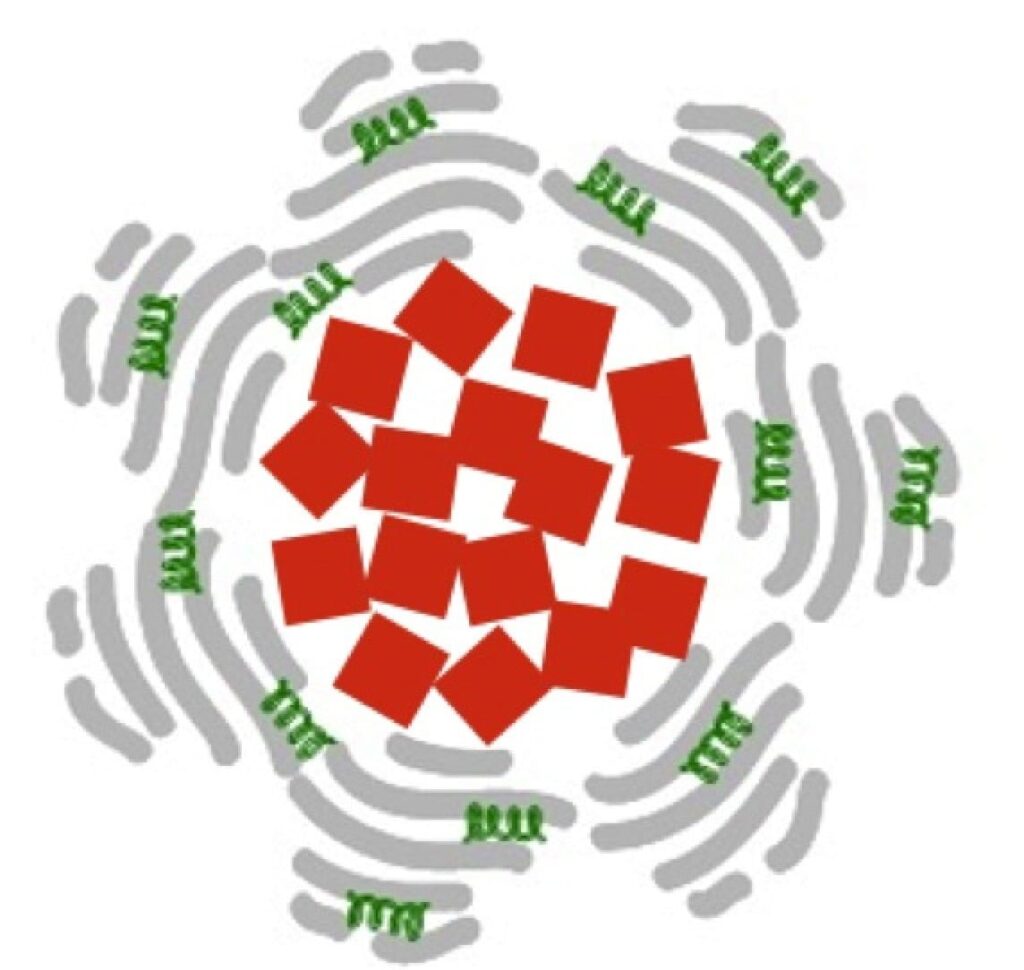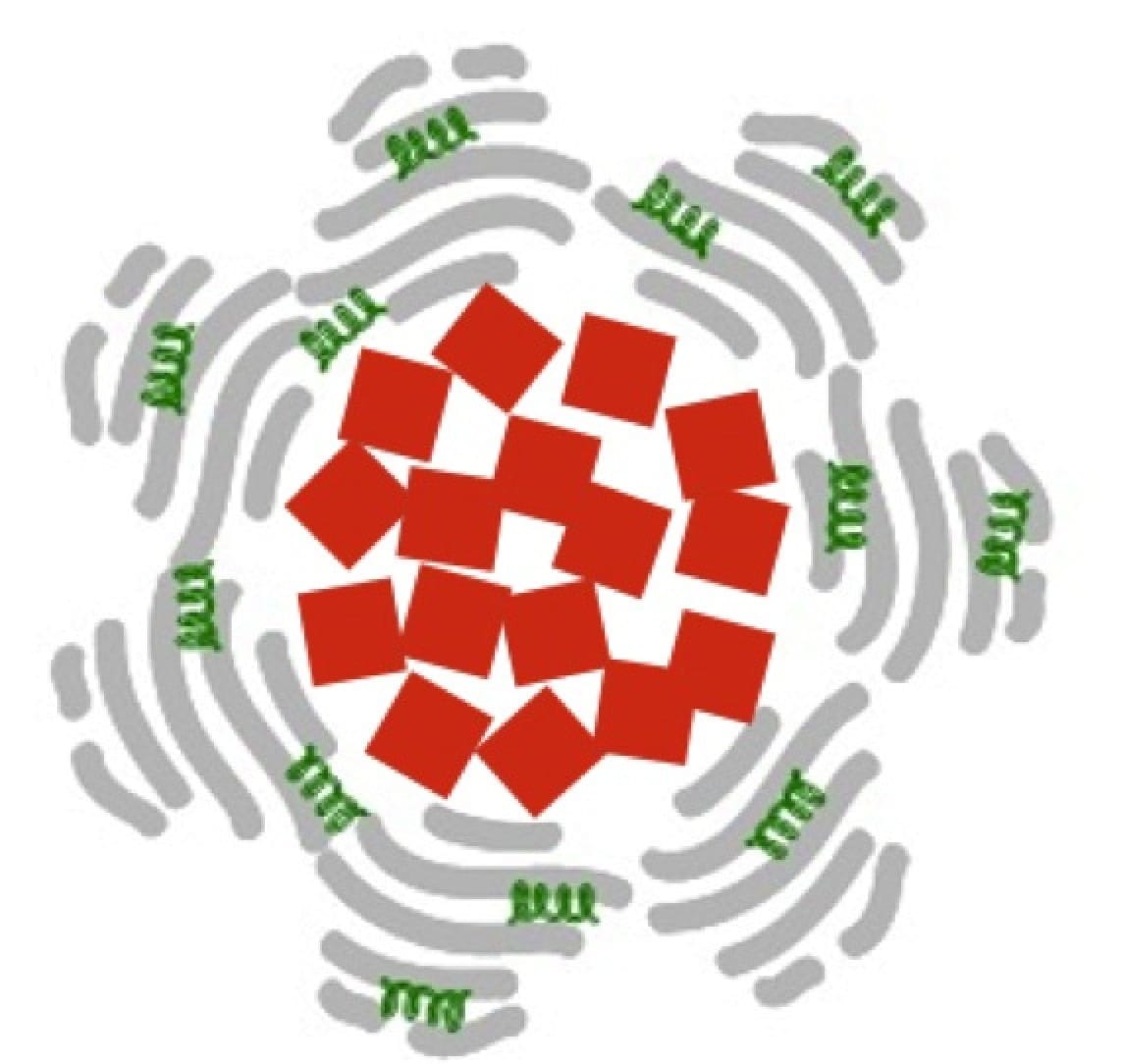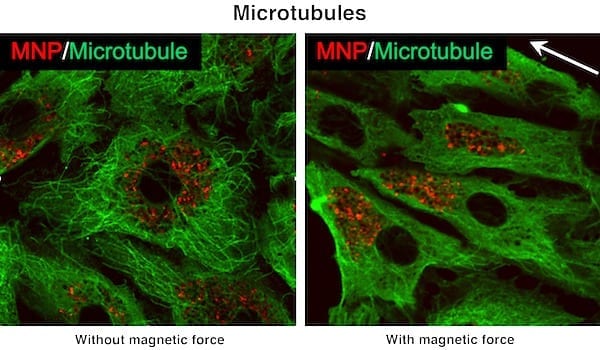
Each nanoparticle is composed of an iron oxide core (red squares) that is swathed in albumin (grey) and the anti-clotting agent tPA (green). The iron oxide cubes are about 20 nm on a side.
By loading magnetic nanoparticles with drugs and dressing them in biochemical camouflage, Houston Methodist researchers say they can destroy blood clots 100 to 1,000 times faster than a commonly used clot-busting technique.
The finding, reported in Advanced Functional Materials(early online), is based on experiments in human blood and mouse clotting models. If the drug delivery system performs similarly well in planned human clinical trials, it could mean a major step forward in the prevention of strokes, heart attacks, pulmonary embolisms, and other dire circumstances where clots — if not quickly busted — can cause severe tissue damage and death.
“We have designed the nanoparticles so that they trap themselves at the site of the clot, which means they can quickly deliver a burst of the commonly used clot-busting drug tPA where it is most needed,” said Paolo Decuzzi, Ph.D., the study’s co-principal investigator.
Decuzzi leads the Houston Methodist Research Institute Dept. of Translational Imaging.
Decuzzi’s group coated iron oxide nanoparticles in albumin, a protein found naturally in blood. The albumin provides a sort of camouflage, giving the loaded nanoparticles time to reach their blood clot target before the body’s immune system recognizes the nanoparticles as invaders and attacks them. Iron oxide was chosen for the core because the researchers plan to use them for magnetic resonance imaging, remote guidance with external magnetic fields, and for further accelerating clot dissolution with localized magnetic heating.
The clot-busting drug loaded into the nanoparticles is tPA, tissue plasminogen activator, an enzyme that is also found naturally in blood at low concentrations. Typically, a small volume of concentrated tPA is injected into a stroke patient’s blood upstream of a confirmed or suspected clot. From there, some of the tPA reaches the clot, but much of it may cruise past or around the clot, potentially ending up anywhere in the circulatory system. tPA is typically used in emergency scenarios by health care staff, but it can be dangerous to patients who are prone to hemorrhage.
“Treating clots is a serious problem for all hospitals, and we take them very seriously as surgeons,” said cardiovascular surgeon and coauthor Alan Lumsden, M.D. “Although tPA and similar drugs can be very effective in rescuing our patients, the drug is broken down quickly in the blood, meaning we have to use more of it to achieve an effective clinical dose. Yet using more of the drug creates its own problems, increasing the risk of hemorrhage. If hemorrhage happens in the brain, it could be fatal.”
Lumsden, who is medical director of the Houston Methodist DeBakey Heart & Vascular Center, said the nanoparticles being developed in Decuzzi’s lab could solve both problems.
“The nanoparticle protects the drug from the body’s defenses, giving the tPA time to work,” he said. “But it also allows us to use less tPA, which could make hemorrhage less likely. We are excited to see if the technique works as phenomenally well for our patients as what we saw in these experiments.”
Read more: Magnetic Nanoparticles Could Stop Blood Clot-Caused Strokes
The Latest on: Magnetic Nanoparticles
[google_news title=”” keyword=”Magnetic Nanoparticles” num_posts=”10″ blurb_length=”0″ show_thumb=”left”]
via Google News
The Latest on: Magnetic Nanoparticles
- Pieces of distant asteroid show ‘bombardment’ that happens to objects in spaceon April 29, 2024 at 9:56 am
Pieces of a distant asteroid show the “bombardment” that objects in space undergo, according to the researchers who conducted it. The new study was undertaken using pieces of the asteroid Ryugu, which ...
- Global Chronic Wound Care Industryon April 29, 2024 at 6:27 am
Global Chronic Wound Care Industry is expected to reach US$ 25,042.5 million at CAGR of 3.8% during forecast period 2023 to 2033 ...
- Japan probe finds scars of micrometeoroid bombardment on asteroid Ryuguon April 29, 2024 at 2:08 am
A nalysis of asteroid Ryugu samples hints at its surface property changes over time, some most likely due to collisions with micrometeoroids. A micrometeoroid refers to a particle tinier than a grain ...
- Probing the effects of interplanetary space on asteroid Ryuguon April 29, 2024 at 2:00 am
Analyzing samples retrieved from the asteroid Ryugu by the Japanese Space Agency's Hayabusa2 spacecraft has revealed new insights into the magnetic and physical bombardment environment of ...
- Micrometeoroid Bombardment and Magnetic Fields: Decoding the Effects of Interplanetary Space on Asteroid Ryuguon April 29, 2024 at 2:00 am
Samples reveal evidence of changes experienced by the surface of asteroid Ryugu, some probably due to micrometeoroid bombardment. Analyzing samples retrieved from the asteroid Ryugu by the Japanese Sp ...
- Unlocking the functional potential of mesoporous materials through modular nanocrystal assemblyon April 25, 2024 at 5:00 pm
The challenge lies in integrating functional components, such as nanoparticles or molecular moieties ... Magnetite nanocrystal-functionalized composites, meanwhile, demonstrated strong magnetic ...
- World's thinnest gold leaf, dubbed 'goldene,' is just 1 atom thickon April 25, 2024 at 12:22 pm
Goldene is the latest 2D material to be made since graphene was first created in 2004. Scientists have created the world's thinnest gold leaf, which is just a single atom thick. The new material, ...
- Diamond dust shines bright in Magnetic Resonance Imagingon April 25, 2024 at 7:37 am
An unexpected discovery surprised a scientist: nanometer-sized diamond particles, which were intended for a completely different purpose, shone brightly in a magnetic resonance imaging experiment -- ...
- Tau Toggling Peptides: One Seeds Fibrils; the Other Dismantles Themon April 19, 2024 at 4:36 pm
Destructive Relief. In the proposed strain relief mechanism, left-twisted tau fibrils bind D-peptides, which initially adopt tau’s left-handed twist to form paired fibrils. Structurally strained, ...
- American science association honors Iowa State innovators for advancing scienceon April 18, 2024 at 9:14 am
The American Association for the Advancement of Science is honoring five Iowa State University researchers for “their scientifically or socially distinguished efforts to advance science." Two of the ...
via Bing News











